
Golden Gate parks offer unique scenery
SAN FRANCISCO — Driving through the fog of the Golden Gate Bridge on a sunny afternoon is a most unique way to arrive to the Presidio, the former Army post for 218 years for the Spain, Mexico and United States.
While cruising down a different road inside the 1,491-acre Golden Gate National Recreational Area, the sound of the Great Horned Owl mixed with the fresh smell of the surrounding forest vegetation.
Nowadays, The Presidio offers golf courses and family picnic areas, but it was once the northernmost outpost of colonial New Spain (Mexico). The U.S. Army took over the site in 1846 and transformed it over 24 years from a dune area to a verdant military post that became part of the national recreational area in 1994.
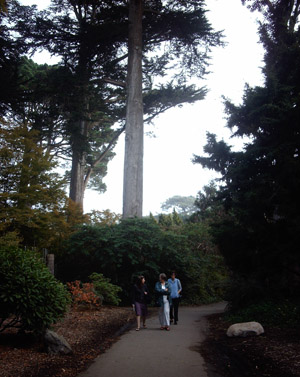 |
A walking path in Golden Gate Park attracts both out-of-town visitors and residents (Photo by Jessy Schuster). |
Leaving The Presidio area shaded by eucalyptus, pines and cypress groves trees, a short drive inside San Francisco will bring you to one of the favorite recreational site of the city: the Golden Gate Park.
The 1,017 square feet park is full of attractions such as museums, gardens, shows and sports that attract about 75,000 people each weekend.
This green area inside the vibrant city is a gateway for families and friends. The main purpose of the park at its construction in 1870 was to provide an urban peaceful gateway for the residents of San Francisco.
Indeed, the park was deeded to the people in 1870. The area was mainly dunes of sand, so it was a long process to transform it into forest vegetation.
John McLaren of Scotland came to San Francisco in 1870 and designed the area with grass, plants and trees. By the 1890s, the park received its first fine-arts museum for the celebration of the Midwinter Fair.
San Francisco was known for its ethnic diversity that was also represented in the park under the form of different theme areas, such as a Japanese village and a Cairo-style street.
| The Red Buddhist Pagoda (Photo by Jessy Schuster). | 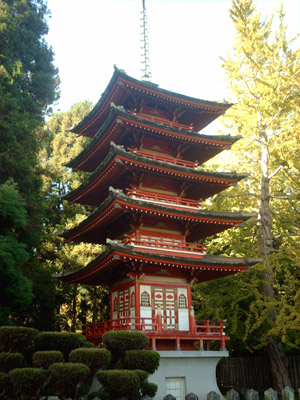 |
Some of the original ideas from the 19th Century are still present today. The Golden Gate Park features different themed areas that attract residents and tourists.
The smell of fresh roses welcomes visitors to the entrance of the park between John F. Kennedy Drive and Park Presidio Drive. The Rose Garden offers a walking path along side the colorful flowers.
The site was chosen in 1961 by the American Rose Society as a place to test roses in the city. Each of the 60 varieties of roses have a unique smell.
A woman walking with a blue Chinese umbrella through the path of roses beds approached her nose to a variety that had a tangerine aroma and took a deep breath.
“This is heaven,” she whispered while smiling.
After the heady experience, a nearby musical beat attracted the senses.
The sound of music became more precise as visitors walked towards a yellow signs stating “Lindy in the Park, Swing Dance Lesson.”
A group of about 30 people, dressed either with casual clothes or large skirts, moved to the beat of 1930s music. Paired by group of two, each couple held each others hands and followed the instructor while laughing.
“Lindy in the Park is a group of people dedicated to preserving the traditional dances of the 20s, 30s, 40s, and 50s,” Tracey Tynan, 46, of Sebastopol, said. “It is a fun and free event. I think it is their 10th years.”
After the vibrant activity, most people walked to a snack bar to order refreshment.
The Walters family stood on line for a quick break from their surrey trip around the park.
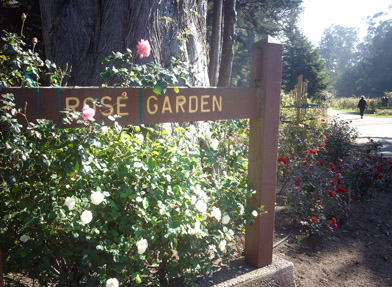 |
The entrance to the Rose Garden at Golden Gate Park (Photo by Jessy Schuster). |
“We used to come here two or three times a month and now we come only a couple of time a year,” said Lisa Walters, 48, of Sebastopol while waiting for her family. “Today we rented a surrey and that is kind of fun, but it is very tiring. We also rented a boat before. It is fun to ride around the lake.”
Golden Gate Park offers outdoor activities such as horse back ridding, rollerblading, surrey riding or bicycling. Most equipment is available for a rental fee at the entrance of the park.
For those who prefer walking around the park, quiet paths inside the forest lead from one attraction to the next.
The main idea of the park is to guide visitors from one theme attraction, such as the Conservatory of Flowers, to another culturally different area, such as the Japanese Tea Garden.
Stepping inside the Asian structure seems like crossing to the Asian continent in 30 seconds. Orange and white Goldfish swam in a gravel river that flowed around small islands of grass and plants that led to a red Buddhist pagoda.
A bronze statue of Buddha built in Japan in 1790 guards the entrance of the tea shop where people sit at small tables to taste jasmine or green tea and fortune cookies.
The garden was built in 1894 for the California Midwinter International Exposition. Makoto Hagiwara, a Japanese landscaper, asked to have the temporary exhibit as a permanent section of the park. He enhanced the park by importing plants, statues, goldfish and a wooden Buddha among others things.
Hagiwara and his family increased the garden to five acres and maintained the site from 1895 to 1942. During World War II, the family was forced to evict and was imprisoned in concentration camps with other Americans of Japanese descent.
| The bridge at the Japanese Tea Garden (Photo by Jessy Schuster). | 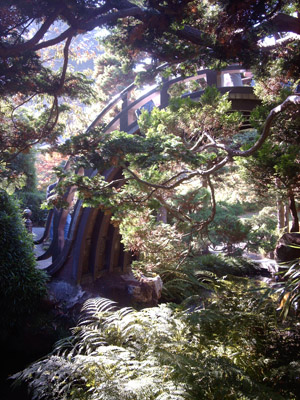 |
The Garden, which was renamed the Oriental Tea Garden, was partially demolished and abandoned. In 1952, its original name was reinstated, and reconstruction started.
Aimee Sullivan, 34, visiting from North Carolina, who rented a moped for the day, came to the Japanese Tea Garden for the first time with her friend Mike Wilson. “It’s magical. It is like a wonderland of natural place,” Sullivan said.
As Angelique Smith, 27, a resident of Miami, stood on the bridge of the garden to pose for a picture, she shared her admiration for the garden.
“I like the uniqueness of the plant in the garden,” Smith said. “I was surprised to see how different plants grow in Japan as opposed to the U.S. The plants appear to swirl up out of the river like a snake.”
After visiting the Japanese Tea Garden, the Botanical Garden is the next stop for scenery for plants and flowers. Squirrels played on the path leading to the lake of the botanical garden.
The garden opened in 1940 as an arboretum. In 1959, Robert Tetlow, a landscape professor at University of California at Berkeley, developed a master plan, including features such as the Great Meadow and the Fountain.
| The Vanzandt family picnics in the park (Photo by Jessy Schuster). | 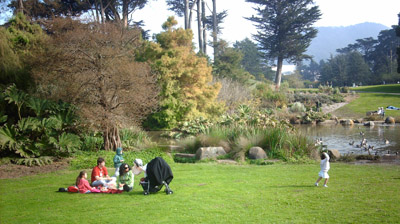 |
The Botanical Garden is also a place for wildlife. Children played with swans and ducks on the border of the lake while parents prepared picnics on the grass area.
“I love to come here with my kids,” said Justin Vanzandt, 35, of San Francisco, who came to the park with his wife and four children. “We have picnics here. Sometimes the children have soccer practice on the park, so we come here once a week.”
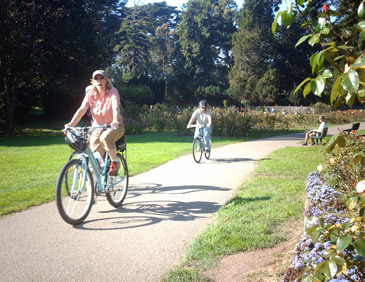 Golden Gate Park is a popular attraction among San Francisco residents and tourists also. Its list of activities ranges from educational attraction such as the California Academy of Sciences, or the D. Young Museum, to cultural unique experience, such as the Japanese Tea Garden, or the Conservatory of Flowers.
Golden Gate Park is a popular attraction among San Francisco residents and tourists also. Its list of activities ranges from educational attraction such as the California Academy of Sciences, or the D. Young Museum, to cultural unique experience, such as the Japanese Tea Garden, or the Conservatory of Flowers.
More relaxing activities such as picnics, or promenade along the lakes and forests can also be alternatives to sports activities such as jogging, hiking or rollerblading.
As the sun set on the Golden Gate Park scene, the San Francisco fog spread slowly encouraging visitors to walk back to their cars.
If You Go
Golden Gate Park
Bounded by Fulton Street, Lincoln Way, Great Highway and Stanyan Street, San Francisco, Calif., 94102, 415-751-2766, http://www.parks.sfgov.org/site/recpark_index.asp, http://www.sfgate.com/traveler/guide/sf/neighborhoods/ggpark.shtml.
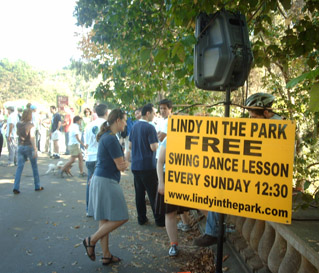 Hours and Fees: Open any time. Cost: Free entrance to the Golden Gate Park, but many museums and other sights charge admission.
Hours and Fees: Open any time. Cost: Free entrance to the Golden Gate Park, but many museums and other sights charge admission.
Directions to Golden Gate Park: The Golden Gate Park is most easily accessed off 19th Avenue, which runs through the middle of it. You can also enter from any of the major streets that bound it. Free shuttles run through the Golden Gate Park on summer weekends and holidays, about every 15 minutes.
Golden Gate Park Shuttle: This free shuttle picks up passengers at 15 locations throughout the park on weekends and holidays, from 10 a.m. to 6 p.m. through mid-December.
Parking: The Music Concourse Garage is open 7:30 a.m. to 10 p.m. every day, and costs $2.50 an hour during the week, $3 an hour on weekends (bicycle parking is free). The entrance is at 10th Avenue and Fulton Street. There is also time-limited parking along JFK Drive, MLK Jr. Drive and side streets within the park.

Comments are Closed